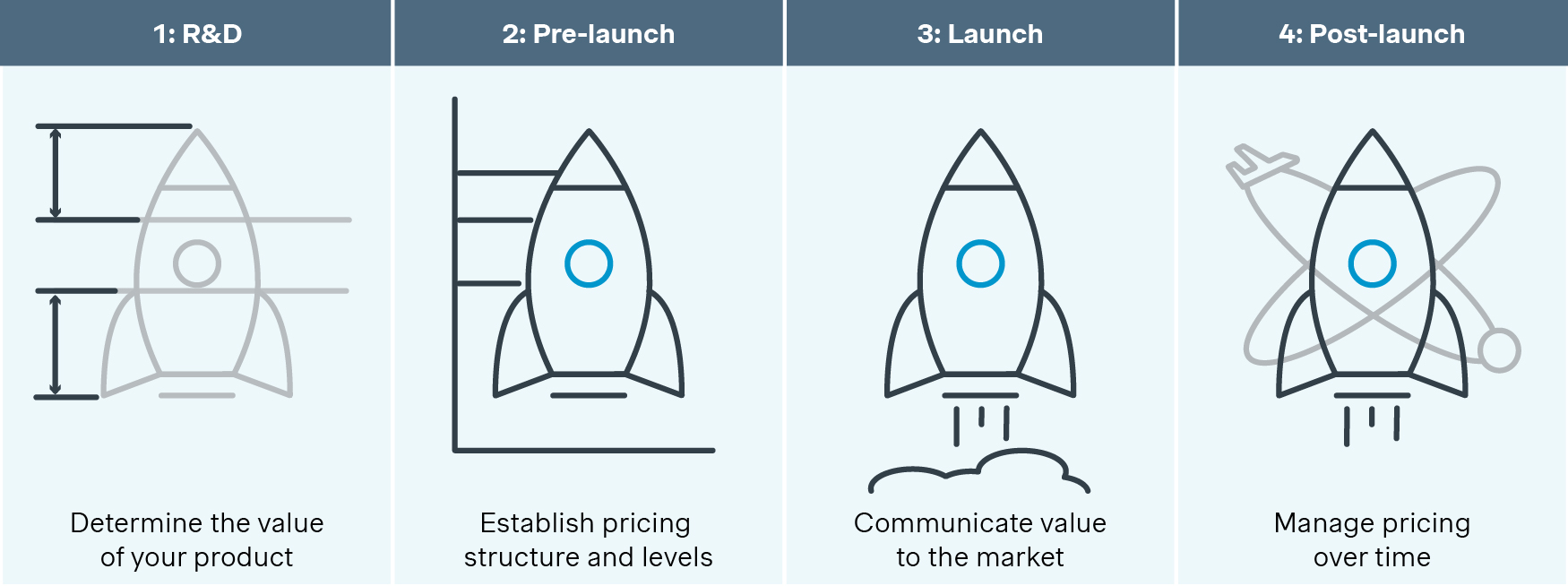Launching a new product is both exhilarating and challenging for businesses. The aim is to make a significant impact in the market. However, the success of a product launch hinges not only on the ingenuity of the product itself. An effective launch strategy is key.
This article explores the essential components of a successful product launch, from defining the target audience and understanding the product to pre-launch preparations and communicating with target customers.
Why is a successful product launch important?
Your product launch serves as an entry point into the market. It allows you to introduce your new offerings to customers and establish a presence in the marketplace. It's an opportunity to showcase the unique features, benefits, and value proposition of your product to the target audience.
A well-executed product launch has the potential to generate significant revenue for businesses, particularly if there is strong demand and customer interest in the product. Sales generated from the launch can contribute to revenue growth and profitability, helping to recoup investments and achieve financial objectives.
It can also facilitate market expansion and growth by opening up new opportunities. You may be able to penetrate new market segments, attract new customers, and expand your reach beyond existing markets. This drives your overall business growth and expansion.
Moreover, a successful product launch can instill confidence in investors and stakeholders, demonstrating your ability to innovate, execute, and deliver value. This impacts investor sentiment, attracts investment capital, and supports future growth initiatives.
Typical product launch challenges
Companies sometimes find themselves launching a new product for which the returns don’t even come close to their initial expectations. How can an organization successfully launch a new product and extract the full value of that product?
Price is a means of capturing the value of a product. A product creation will succeed if it follows two simple rules.
- It offers customers value
- The product provider can capture that value in the price.
This sounds easy enough, but there are several reasons why companies get it wrong.
- The product doesn't have the right features. Often, a new product does not have the best possible features. Either it has features for which customers have no interest and no willingness to pay, or there are too many features, which may lead to high prices.
- Price doesn't reflect value. Companies rarely consider customers' willingness to pay in the first stages of a product development process. This results in product prices that are primarily based on historic product prices and cost-plus strategies. The right price metric (e.g., price per unit, price per page, price per kilometer) can help to ensure the right amount of value is delivered. This helps you to improve your company’s relative competitive positioning.
- Poorly estimating demand. Many companies have a hard time accurately estimating the demand for their products. This is a major hindrance, as forecasting demand is crucial to getting the price right. If demand exceeds supply, price skimming can capture the excess willingness to pay from early adopters. This is why it is important to build a robust business case around demand and supply expectations.
- Neglecting portfolio price distances. It’s not uncommon to find premium products that are unattractive to most customers. A more thorough segmentation can prevent this.
Also, be careful that your cheapest products or packages don’t already cover the majority of customers’ needs. This will not fully capture the varying willingness to pay between segments. If you optimize your price ranges, product lines will reflect various customer needs based on the willingness to pay and perceived value.
How to improve new product launches
For many companies, pricing is an afterthought when launching new products. Often, the monetization strategy only comes to mind when companies are ready to market the product.
Many mistakes are made in pricing when developing new products, resulting in disappointing profits. Typically, the mistake becomes apparent when the new product struggles to generate the sales figures forecasted. By then, it’s almost too late to repair the damage.
The bottom line is that if you don’t focus on pricing during the product development process, you may make a costly mistake.
Product launch pricing: Best practices
Creating a comprehensive new product pricing process can feel like an insurmountable task. There is often so much complexity and uncertainty.
Is the product truly innovative? Will customers immediately understand the value? How can you price for different user groups? Does market adoption matter for value?
It may be a daunting task, but a comprehensive new product pricing process will definitely pay off. Take, for example, this typical new product.
The new product offered many improved features and exciting innovations, but the monetization potential was much lower than expected. What happened?
No one had linked consumer needs with value and willingness to pay. Therefore, the product design team acted only on needs and their internal capacity to meet them. This created a product with too many features that were either very expensive or just “nice to have”. Too many consumers refused to pay.
Furthermore, the company did not identify consumer needs by segment, and the product did not meet them. Therefore, the company missed an opportunity to differentiate prices and extract the full value.
Pricing must be a constant source of input throughout the entire development and launch process. So, what defines an optimal price? Here are three requirements.
- Requirement 1: The price should reflect the brand premium. The first requirement of an optimal price is that it should reflect the brand premium. Starbucks, for instance, managed to price its coffee three to five times higher than the local competition. The brand premium is clearly communicated via pricing.
- Requirement 2: Differentiate prices by segments. Optimal prices should be differentiated by segments. Many deals can be won in different regions, sales channels, or industries if you identify the opportunities and translate them into price differentiation that captures the full value of each segment.
- Requirement 3: The price should focus on customer value. Last but not least, price should always focus on customer value. To get your customers to rethink the value of the product components, consider increasing your product’s price. By changing the price metrics of a laundry detergent, for example, you can get your customers to start thinking of value in terms of price per load instead of price per kilogram.
Simon-Kucher’s product launch checklist
Our checklist embeds pricing throughout the entire development and launch process – from the R&D phase to the post-launch phase.
- Research and development phase. First, identify and validate customer needs by analyzing and quantifying the product's value. It is very important to find out what kind of premium your product deserves and the segment-specific willingness of your customers to pay. In this phase, a business case must eventually be built.
- Pre-launch phase. Develop a pricing strategy. Explore the price elasticity of your product, consider pricing throughout the product’s lifecycle, and factor in competitive reactions. When you have set the general strategy, you should optimize the price structure by answering several questions.
How is your fee structured? What is your price metric? Will you bundle your product? Ultimately, you should test your findings in the market and adjust your strategy and business case accordingly. - Product launch phase. Draft guidelines and policies. Details regarding pricing, marketing and sales provide direction for a successful launch. In this phase, you should establish a KPI framework to track performance. Furthermore, you should communicate value to the market and train your sales force to sell the value.
- Post-launch phase. This is not a time for your organization to kick back and relax. Instead, it should be collecting pricing feedback from the market and tracing KPIs to see how the product performs. Adjust your tactics and strategy if necessary.
Avoid mistakes that could lead to disappointing returns. This checklist helps your organization to embed a rigorous pricing process in all product development phases.
New product monetization examples
Here are just a few examples of monetization strategies for new products. The most suitable strategy will depend on factors such as the product's nature, target market, competitive landscape, and business objectives.
- Subscription model. Offer the new product on a subscription basis. Here, customers pay a recurring fee at regular intervals (e.g., monthly, annually) to access the product or its features. This model provides predictable revenue streams and encourages customer retention.
- Freemium model. Provide a basic version of the product for free, while offering premium features or enhanced functionality for a fee. This allows customers to experience the product before committing to a purchase. It can also drive conversions from free users to paid subscribers.
- Tiered pricing. Offer the new product in multiple tiers or packages, each with different features, levels of service, or usage limits at varying price points. This allows customers to choose the option that best fits their needs and budget, maximizing revenue potential.
- Pay-per-use. Charge customers based on their usage or consumption of the product. For example, a software-as-a-service (SaaS) product might charge customers based on the number of transactions, storage space, or data bandwidth used. This model aligns pricing with value delivered and can appeal to customers with variable usage needs.
- Bundling and cross-selling. Bundle the new product with complementary products or services and offer them together at a discounted price. Alternatively, cross-sell the new product alongside existing products or services to increase overall customer value and drive incremental revenue.
- Loyalty programs. Implement loyalty programs or rewards schemes where customers earn points, discounts, or exclusive benefits for purchasing or engaging with the new product. This incentivizes repeat purchases and customer retention while fostering brand loyalty.
- Customization and add-ons. Offer customization options or add-on features that customers can purchase to enhance the functionality or personalize their experience with the new product. This allows you to capture additional revenue from customers willing to pay for premium or tailored offerings.
Preparing your organization for product launch success
Crafting a winning pricing strategy for your latest offerings is essential for driving profitability and securing market share. Whether you're launching a groundbreaking innovation or expanding your product portfolio, the decisions you make around pricing can make or break the success of your venture.
It is clear that pricing should be key from the start of the product development lifecycle. But this is easier said than done. A myriad of challenges await you.
What are the optimal product features? Is the price in line with the value being delivered? Do you have a sound business case? Are prices optimized throughout the portfolio?
For a true optimization of your new product pricing process, you need to factor in pricing already in the first phase of product development.
How Simon-Kucher can help
Would you like to change the way your organization thinks about new product pricing? Would you like to structure your approach to new product pricing challenges and prepare your organization to make new product pricing decisions more confidently? Then we can help.
At Simon-Kucher, we specialize in helping organizations like yours navigate the complexities of new product pricing with confidence and clarity. Our proven methodologies and expert guidance can transform your approach to pricing challenges, empowering your product team to make informed decisions and unlock the full potential of your new product launches.
We work with your organization to structure your approach to new product pricing challenges, prepare your team for launch day success, and build awareness of your offerings in the market.
Reach out to Simon-Kucher today!




